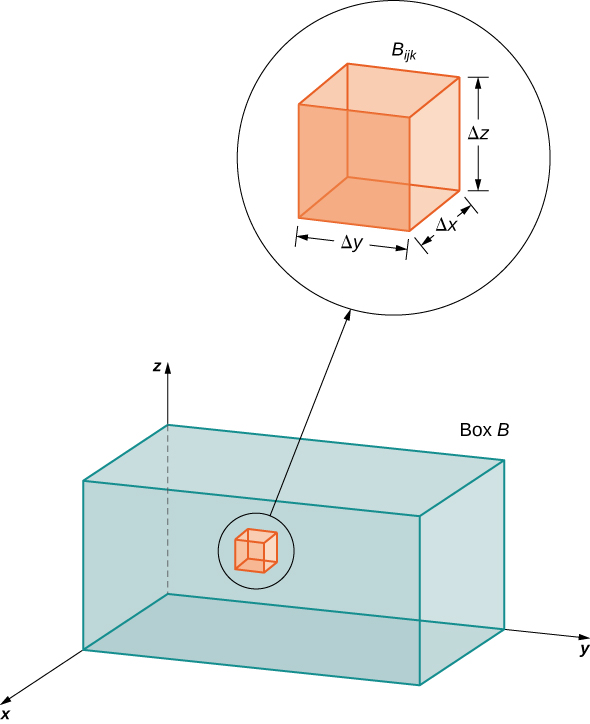
In Double Integrals over Rectangular Regions, we discussed the double integral of a function
of two variables over a rectangular region in the plane. In this section we define the triple integral of a function
of three variables over a rectangular solid box in space,
Later in this section we extend the definition to more general regions in
We can define a rectangular box
in
as
We follow a similar procedure to what we did in Double Integrals over Rectangular Regions. We divide the interval
into
subintervals
of equal length
divide the interval
into
subintervals
of equal length
and divide the interval
into
subintervals
of equal length
Then the rectangular box
is subdivided into
subboxes
as shown in [link].

For each
consider a sample point
in each sub-box
We see that its volume is
Form the triple Riemann sum
We define the triple integral in terms of the limit of a triple Riemann sum, as we did for the double integral in terms of a double Riemann sum.
The triple integral of a function
over a rectangular box
is defined as
if this limit exists.
When the triple integral exists on
the function
is said to be integrable on
Also, the triple integral exists if
is continuous on
Therefore, we will use continuous functions for our examples. However, continuity is sufficient but not necessary; in other words,
is bounded on
and continuous except possibly on the boundary of
The sample point
can be any point in the rectangular sub-box
and all the properties of a double integral apply to a triple integral. Just as the double integral has many practical applications, the triple integral also has many applications, which we discuss in later sections.
Now that we have developed the concept of the triple integral, we need to know how to compute it. Just as in the case of the double integral, we can have an iterated triple integral, and consequently, a version of Fubini’s thereom for triple integrals exists.
If
is continuous on a rectangular box
then
This integral is also equal to any of the other five possible orderings for the iterated triple integral.
For
and
real numbers, the iterated triple integral can be expressed in six different orderings:
For a rectangular box, the order of integration does not make any significant difference in the level of difficulty in computation. We compute triple integrals using Fubini’s Theorem rather than using the Riemann sum definition. We follow the order of integration in the same way as we did for double integrals (that is, from inside to outside).
Evaluate the triple integral
The order of integration is specified in the problem, so integrate with respect to
first, then y, and then
Evaluate the triple integral
where
as shown in the following figure.
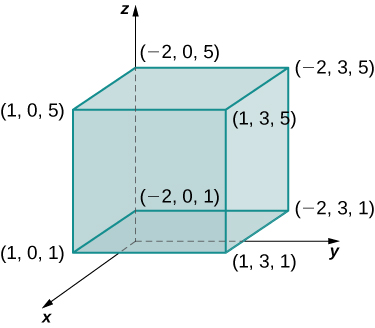
The order is not specified, but we can use the iterated integral in any order without changing the level of difficulty. Choose, say, to integrate y first, then x, and then z.
Now try to integrate in a different order just to see that we get the same answer. Choose to integrate with respect to
first, then
and then
Evaluate the triple integral
where
Follow the steps in the previous example.
We now expand the definition of the triple integral to compute a triple integral over a more general bounded region
in
The general bounded regions we will consider are of three types. First, let
be the bounded region that is a projection of
onto the
-plane. Suppose the region
in
has the form
For two functions
and
such that
for all
in
as shown in the following figure.
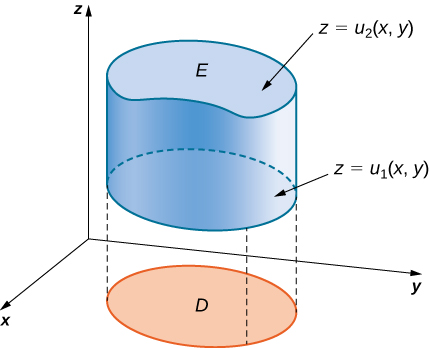
The triple integral of a continuous function
over a general three-dimensional region
in
where
is the projection of
onto the
-plane, is
Similarly, we can consider a general bounded region
in the
-plane and two functions
and
such that
for all
in
Then we can describe the solid region
in
as
where
is the projection of
onto the
-plane and the triple integral is
Finally, if
is a general bounded region in the
-plane and we have two functions
and
such that
for all
in
then the solid region
in
can be described as
where
is the projection of
onto the
-plane and the triple integral is
Note that the region
in any of the planes may be of Type I or Type II as described in Double Integrals over General Regions. If
in the
-plane is of Type I ([link]), then
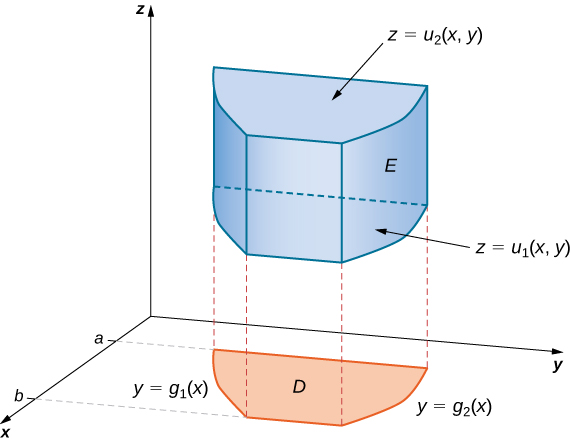
Then the triple integral becomes
If
in the
-plane is of Type II ([link]), then
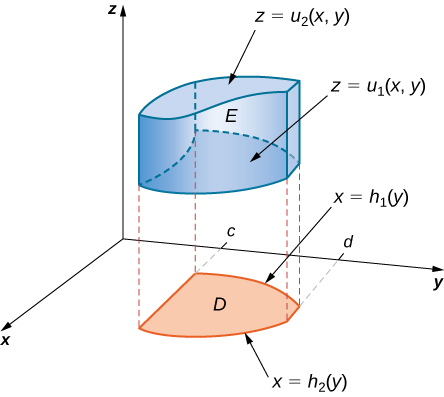
Then the triple integral becomes
Evaluate the triple integral of the function
over the solid tetrahedron bounded by the planes
and
[link] shows the solid tetrahedron
and its projection
on the
-plane.
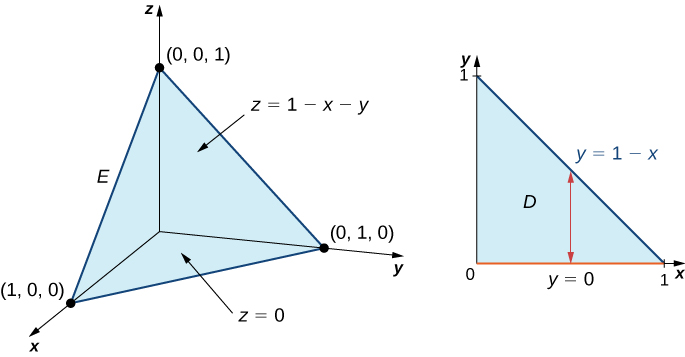
We can describe the solid region tetrahedron as
Hence, the triple integral is
To simplify the calculation, first evaluate the integral
We have
Now evaluate the integral
obtaining
Finally, evaluate
Putting it all together, we have
Just as we used the double integral
to find the area of a general bounded region
we can use
to find the volume of a general solid bounded region
The next example illustrates the method.
Find the volume of a right pyramid that has the square base in the
-plane
and vertex at the point
as shown in the following figure.
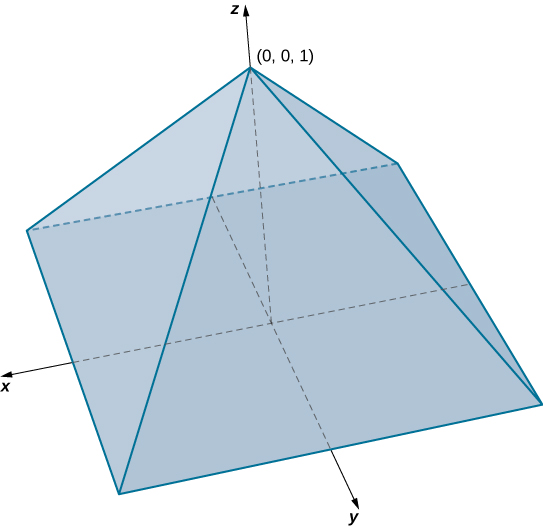
In this pyramid the value of
changes from
and at each height
the cross section of the pyramid for any value of
is the square
Hence, the volume of the pyramid is
where
Thus, we have
Hence, the volume of the pyramid is
cubic units.
Consider the solid sphere
Write the triple integral
for an arbitrary function
as an iterated integral. Then evaluate this triple integral with
Notice that this gives the volume of a sphere using a triple integral.
Follow the steps in the previous example. Use symmetry.
As we have already seen in double integrals over general bounded regions, changing the order of the integration is done quite often to simplify the computation. With a triple integral over a rectangular box, the order of integration does not change the level of difficulty of the calculation. However, with a triple integral over a general bounded region, choosing an appropriate order of integration can simplify the computation quite a bit. Sometimes making the change to polar coordinates can also be very helpful. We demonstrate two examples here.
Consider the iterated integral
The order of integration here is first with respect to z, then y, and then x. Express this integral by changing the order of integration to be first with respect to x, then z, and then
Verify that the value of the integral is the same if we let
The best way to do this is to sketch the region
and its projections onto each of the three coordinate planes. Thus, let
and
We need to express this triple integral as
Knowing the region
we can draw the following projections ([link]):
on the
-plane is
on the
-plane is
and
on the
-plane is

Now we can describe the same region
as
and consequently, the triple integral becomes
Now assume that
in each of the integrals. Then we have
The answers match.
Write five different iterated integrals equal to the given integral
(i)
(ii)
(iii)
(iv)
(v)
Follow the steps in the previous example, using the region
as
and describe and sketch the projections onto each of the three planes, five different times.
Evaluate the triple integral
where
is the region bounded by the paraboloid
([link]) and the plane
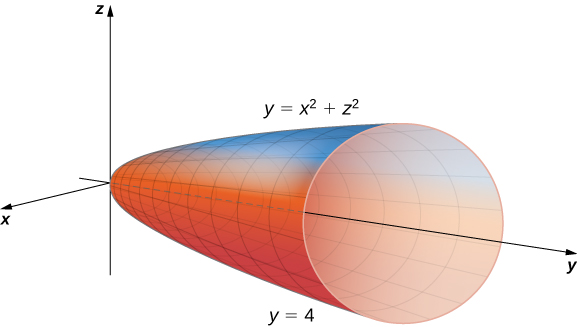
The projection of the solid region
onto the
-plane is the region bounded above by
and below by the parabola
as shown.
![Cross section in the xy-plane of the paraboloid in [link]. In the x y plane, the graph of y = x squared is shown with the line y = 4 intersecting the graph at (negative 2, 4) and (2, 4).](../resources/CNX_Calc_Figure_15_04_010.jpg)
Thus, we have
The triple integral becomes
This expression is difficult to compute, so consider the projection of
onto the
-plane. This is a circular disc
So we obtain
Here the order of integration changes from being first with respect to
then
and then
to being first with respect to
then to
and then to
It will soon be clear how this change can be beneficial for computation. We have
Now use the polar substitution
and
in the
-plane. This is essentially the same thing as when we used polar coordinates in the
-plane, except we are replacing
by
Consequently the limits of integration change and we have, by using
Recall that we found the average value of a function of two variables by evaluating the double integral over a region on the plane and then dividing by the area of the region. Similarly, we can find the average value of a function in three variables by evaluating the triple integral over a solid region and then dividing by the volume of the solid.
If
is integrable over a solid bounded region
with positive volume
then the average value of the function is
Note that the volume is
The temperature at a point
of a solid
bounded by the coordinate planes and the plane
is
Find the average temperature over the solid.
Use the theorem given above and the triple integral to find the numerator and the denominator. Then do the division. Notice that the plane
has intercepts
and
The region
looks like
Hence the triple integral of the temperature is
The volume evaluation is
Hence the average value is
degrees Celsius.
Find the average value of the function
over the cube with sides of length
units in the first octant with one vertex at the origin and edges parallel to the coordinate axes.
Follow the steps in the previous example.
is continuous on a rectangular box
then
and is also equal to any of the other five possible orderings for the iterated triple integral.
we use the triple integral
In the following exercises, evaluate the triple integrals over the rectangular solid box
where
where
where
where
In the following exercises, change the order of integration by integrating first with respect to
then
then
Let
be continuous functions on
and
respectively, where
are real numbers such that
Show that
Let
be differential functions on
and
respectively, where
are real numbers such that
Show that
In the following exercises, evaluate the triple integrals over the bounded region
where
where
where
where
In the following exercises, evaluate the triple integrals over the indicated bounded region
where
where
where
where
In the following exercises, evaluate the triple integrals over the bounded region
of the form
where
where
where
where
In the following exercises, evaluate the triple integrals over the bounded region
where
where
where
where
In the following exercises, evaluate the triple integrals over the bounded region
where
is the projection of
onto the
-plane.
where
where
where
where
The solid
bounded by
and
is shown in the following figure. Evaluate the integral
by integrating first with respect to
then
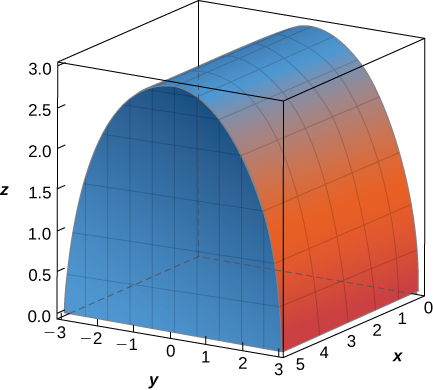
The solid
bounded by
and
is given in the following figure. Evaluate the integral
by integrating first with respect to
then
and then
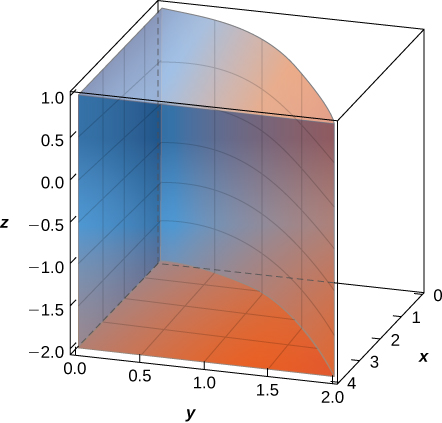
[T] The volume of a solid
is given by the integral
Use a computer algebra system (CAS) to graph
and find its volume. Round your answer to two decimal places.
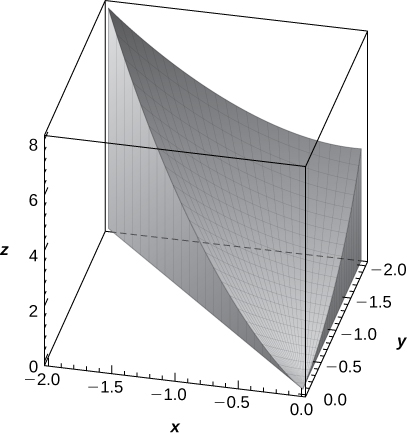
[T] The volume of a solid
is given by the integral
Use a CAS to graph
and find its volume
Round your answer to two decimal places.
In the following exercises, use two circular permutations of the variables
to write new integrals whose values equal the value of the original integral. A circular permutation of
is the arrangement of the numbers in one of the following orders:
Set up the integral that gives the volume of the solid
bounded by
and
where
Set up the integral that gives the volume of the solid
bounded by
and
where
Find the average value of the function
over the parallelepiped determined by
and
Find the average value of the function
over the solid
situated in the first octant.
Find the volume of the solid
that lies under the plane
and whose projection onto the
-plane is bounded by
and
Find the volume of the solid E that lies under the plane
and whose projection onto the
-plane is bounded by
and
Consider the pyramid with the base in the
-plane of
and the vertex at the point
and
a. Answers may vary; b.
Consider the pyramid with the base in the
-plane of
and the vertex at the point
and
The solid
bounded by the sphere of equation
with
and located in the first octant is represented in the following figure.
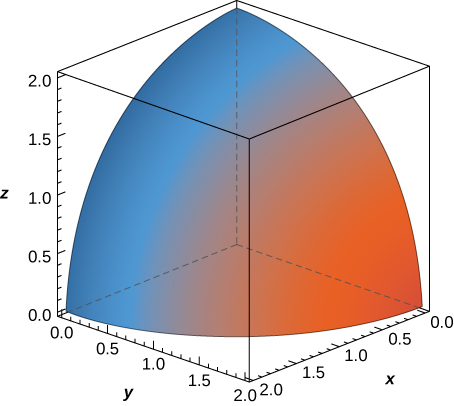
by integrating first with respect to
then with
and then with
a.
b.
The solid
bounded by the equation
and located in the first octant is represented in the following figure.
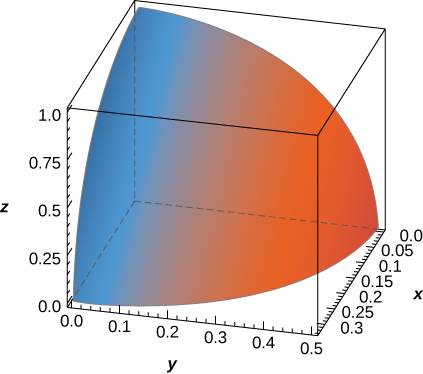
by integrating first with respect to
then with
and then with
Find the volume of the prism with vertices
Find the volume of the prism with vertices
The solid
bounded by
and situated in the first octant is given in the following figure. Find the volume of the solid.
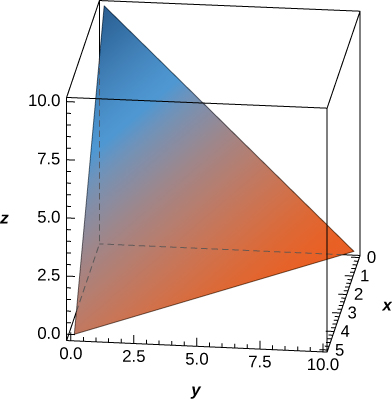
The solid
bounded by
and situated in the first octant is given in the following figure. Find the volume of the solid.
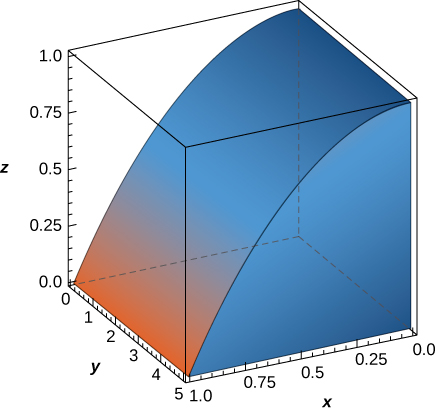
The midpoint rule for the triple integral
over the rectangular solid box
is a generalization of the midpoint rule for double integrals. The region
is divided into subboxes of equal sizes and the integral is approximated by the triple Riemann sum
where
is the center of the box
and
is the volume of each subbox. Apply the midpoint rule to approximate
over the solid
by using a partition of eight cubes of equal size. Round your answer to three decimal places.
[T]
over the solid
by using a partition of eight cubes of equal size. Round your answer to three decimal places.
cubes of equal size, where
Suppose that the temperature in degrees Celsius at a point
of a solid
bounded by the coordinate planes and
is
Find the average temperature over the solid.
Suppose that the temperature in degrees Fahrenheit at a point
of a solid
bounded by the coordinate planes and
is
Find the average temperature over the solid.
Show that the volume of a right square pyramid of height
and side length
is
by using triple integrals.
Show that the volume of a regular right hexagonal prism of edge length
is
by using triple integrals.
Show that the volume of a regular right hexagonal pyramid of edge length
is
by using triple integrals.
If the charge density at an arbitrary point
of a solid
is given by the function
then the total charge inside the solid is defined as the triple integral
Assume that the charge density of the solid
enclosed by the paraboloids
and
is equal to the distance from an arbitrary point of
to the origin. Set up the integral that gives the total charge inside the solid
over a rectangular solid box
is the limit of a Riemann sum for a function of three variables, if this limit exists

You can also download for free at http://cnx.org/contents/9a1df55a-b167-4736-b5ad-15d996704270@5.1
Attribution: